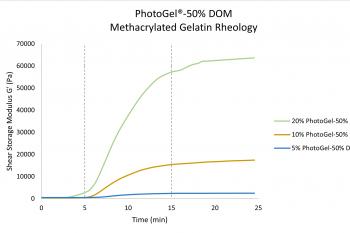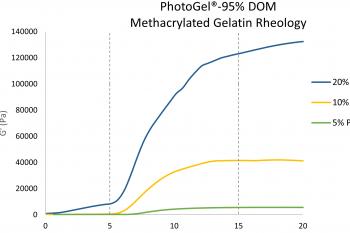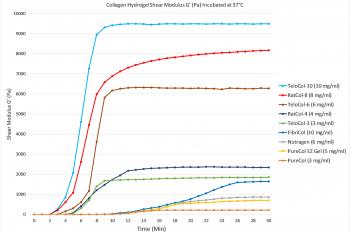Tunable Stiffness
Tunable 3D Hydrogels from Advanced BioMatrix
The rigidity (stiffness) of the 3D hydrogel encompassing cells can affect cell propagation, differentiation, lineage specification, gene expression, morphology, self-renewal, pluripotency and migration.
Contact a Technical Scientist to find a 3D hydrogel that fits your application or continue reading to learn more!
3D Hydrogels can be customized or tuned to provide an in vivo-like environment. Natural hydrogels from proteins such as collagen or other extracellular matrix components such as glucosaminoglycans are of special interest due to their biocompatibility and resemblance to the human body.

3D Hydrogels Options
At Advanced BioMatrix, we offer a range of products that can be tuned to create 3D hydrogels of varying ridigity or stiffness. These products include:
- Type I collagen solutions
- Methacrylated Extracellular matrices such as Collagen, Gelatin, Hyaluronic Acid, Alginate, Silk Fibroin and Dextran
- Thiolated hyaluronic acid
Contact a Technical Scientist to find a 3D hydrogel that fits your application or continue reading to learn more!

Tunability Methods
The most common methods used for tuning substrate stiffness include adjusting:
- Protein concentration
- Temperature
- Degree of methacrylation or thiolation
- pH
- Type of photoinitiator
- Photoinitiator concentration
- Photocrosslinking time, intensity or wavelength
By adjusting these various "knobs," researchers create 3D hydrogels of various stiffness covering most of the physiologically relevant range (0.2 kPa - 120 kPa).
Contact a Technical Scientist to discuss customizing a hydrogel that makes your cells happy, or continue reading to learn more!

Photocrosslinking and Chemical Crosslinking
Photo and chemical crosslinking methods can increase the mechanical properties of the hydrogel in both strength and flexibility of the hydrogel as compared to thermally crosslinked hydrogels.
Tunable hydrogels typically have functional groups, such as OH, COOH, and NH2. 3D networks can be established by covalent bonding functional groups using photocrosslinking such as employed with PhotoCol®, PhotoHA®, PhotoGel®, PhotoHA®, PhotoAlginate® and PhotoSilk®.
The HyStem® product line employs a chemical crosslinking method using thio-reactive chemistry.
This graph shows the gel stiffness of PhotoGel® (Methacrylated Gelatin) photocrosslinked at various concentrations using LAP as the photoinitiator and 405nm blue light at various concentrations with 10 minutes of photocrosslinking.

Contact a Technical Scientist for more white papers, crosslinking data or help in finding the right material for your applications!






